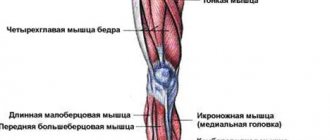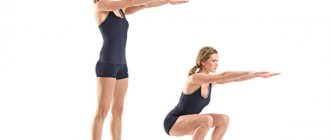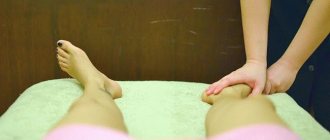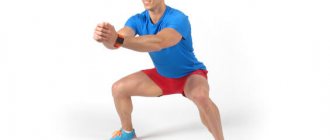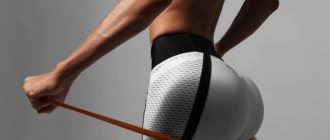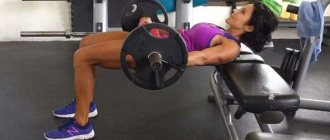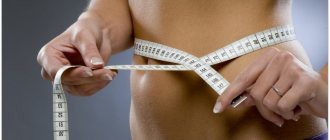What muscles are involved?
There are many types of squats , of course, each of them works certain muscles to varying degrees. But it is still possible to identify which of them work when squatting in women and men:
- quadriceps femoris and quadriceps - if you squat often, the muscle responsible for straightening the leg at the knee will sway;
- the back muscles are partially responsible for these actions, because they have to help support the torso in a straight position;
- the press helps to maintain balance, you can pump the lower and middle press when squats;
- hamstrings;
- the calf supports the torso in balance, maintaining an upright position, and helps to avoid falls;
- The gluteus maximus and popliteus muscles are responsible for straightening your legs during exercise.
As you can see, one exercise involves many muscle groups. Therefore, it is beneficial for men and women equally. But it is the female sex who loves it more, because girls can use it to tighten their legs and buttocks, additionally working their back. The exercise can be safely classified as basic; with the right approach, it can replace a full-fledged complex with exercise equipment.
We figured out what muscles work. But before training, it is imperative to warm up the muscles in order to prepare them for the upcoming loads - there is no way to do without this. A warm-up can include light jogging (even on the spot), brisk walking, jumping rope exercises, and much more. By warming up your muscles beforehand, you reduce the risk of injury. And the muscle tissues of the limbs are prepared for squats, blood circulation improves. Therefore, all loads will be perceived by your body much better.
Top 7 squats for the gluteal muscles and technique for performing them
There are many different sets of squats to form beautiful and elastic buttocks. When choosing a training program for yourself, be sure to pay attention to whether it is right for you. Classes are selected individually for each person . In this case, various factors are taken into account - general health, level of physical development, psycho-emotional state.
Classic
The classic glute squat technique engages all the leg muscles and gluteal muscles.
It is the classic squats that are included in the TOP 7 best exercises for the buttocks, thighs and legs.
- Starting position – back straight, feet hip-width apart, arms freely positioned along the body.
- As you exhale, move your pelvis back, squat slowly until a right angle is formed. The thighs are parallel to the floor.
- We return to the starting position, relax while inhaling.
There is also a static version of this movement - it is called “Chair against the wall”
Watch the video for more details:
Deep
Deep squats for the buttocks are very effective, but place a lot of stress on the knee joints . This exercise lowers your hips below your knees.
Watch the video for more details:
Caution! It is advisable to perform it under the guidance of an instructor, otherwise you may injure your knees.
With narrow feet
When performing the exercise, the gluteus maximus and quadriceps muscles take on the main load.
- Starting position – back straight, feet together, arms down along the body, or in front of you, as shown in the picture.
- We perform it like a regular squat.
For detailed techniques, watch the video:
Pay attention! Another very effective exercise is walking on your buttocks. In combination with squats, together they will give incredible results. Besides getting rid of cellulite, butt walking has many other benefits - 9 Incredible Facts About Butt Walking.
"Sumo"
The muscles of the legs and buttocks are well worked out, and fat is removed from the inner thigh. We perform it in the same way as a regular squat.
The difference is that the stance of the legs is wider, and the arms are usually weighed down with dumbbells.
Shown more clearly below:
"Plie"
The gluteal muscles and quadriceps femoris are worked.
- Starting position – back straight, feet shoulder-width apart, toes turned outward, hands on the belt.
- We carry out according to the standard scheme.
More details in the video:
"Curtsy"
All three gluteal muscles are involved in the exercise; this type of squat contributes to their good development. Effectively removes “ears” on the thighs.
- We stand straight, back straight. One leg is in front, the other is behind, resting on the toe.
- We squat smoothly, bending our knees. We keep the body weight on the front leg. Slowly return to the starting position.
Using weights
As you adapt to the loads, all types of glute squats can be done with different loads. These can be dumbbells, barbells, or, at home, plastic bottles filled with water.
Be sure to watch: 4 of the most effective types of squats with dumbbells for the buttocks
- Starting position - stand straight, do not slouch, feet shoulder-width apart.
- We hold a kettlebell or dumbbells with both hands, bent at the elbow joints. Elbows pressed to the sides.
- Smoothly squat using any technology described above.
You can use water bottles or dumbbells.
Feet shoulder-width apart, heels firmly on the floor. Your arms can be extended in front of you or lowered down. Carefully! Contraindications to exercise are some heart and vascular diseases, arthritis, fever, high blood pressure. It is best to consult a doctor.
Common Mistakes
The correct technique will help to work out the muscles efficiently, the occurrence of injuries is reduced to zero, there is no stress on the knee joints and back. But beginners often make common mistakes that can lead to irreparable consequences.
- The knees extend beyond the toes. The joints are overloaded, increasing the risk of injury and sprains. Your knees should always be in the same line as your toes.
- Relaxation of the back and shoulders. Does your back automatically round when you squat? We need to do something about this! The spine should be in a neutral position, then the exercise will be effective and safe for you. You can slightly lower your shoulder blades so that your core area is also worked.
- Poor depth. Many beginners find it difficult to squat deep enough and worry about their knees. But if you do everything correctly, then there is no danger in this. Watch your hips: they should fall below your knees. Then such a squat can be considered effective.
- Lack of regularity. You need to remember your classes at least three times a day. To pump up different muscle groups, combine different variations of this activity.
Plie squats (Sumo squats)
Plie squats differ from classic ones in that they are performed with a wide stance. In this type of squats, the muscles of the inner thigh
. You can do it with a barbell, or with dumbbells or a kettlebell in your hands.
video - technique of plie squats with dumbbells for girls
Correct technique
- place your feet wider than your shoulders (so that when squatting, your shin is perpendicular to the floor);
- turn your socks 120 degrees;
- squat down so that your thighs are parallel to the floor;
- keep your back straight, do not round your shoulders;
- tighten your abs to support your back;
- When lifting up, additionally strain your gluteal muscles.
The difference between the plie and sumo techniques
- during a sumo squat, the pelvis is pulled back and the back bends forward, as in a classic squat, and you can take on more working weight;
- during a plie squat, the pelvis is almost not retracted back and the back is held vertically, while less weight is used, and the load on the muscles of the inner thigh increases.
Execution Rules
It is worth considering the exercise in the classic version , where your own weight is used. Once you learn this technique, you will be able to perform other types of squats without any problems.
- Stand straight with your feet slightly wider than your shoulders. Shift your weight into your heels and into your arches.
- Knees over ankles, hips over your knees. When moving, the spine should remain in a neutral position, do not strain it.
- Extend your arms in front of you, they will be parallel to the floor. Point your palms down. Inhale, begin to push your hips back, slowly bending your legs.
- Look straight at one point, straight back, don’t let your shoulders drop. As you deepen your squat, watch your knees and feet—they must remain in line!
- Go as low as you can. You can lower your hips to knee level or lower if you can.
- Push through your heels as you return to the starting position. Then the core muscles will also be involved in the work.
Squats are an effective and at the same time very simple exercise. With its help, you can work out the muscle groups you need, forming a beautiful and toned body that will definitely evoke admiring glances. Remember to perform them regularly, do not forget about safety precautions, then positive results will not be long in coming. Try it - this is the only way to be sure of the effectiveness of the activities, for which you do not necessarily have to leave your home.
Originally posted 2018-01-29 11:56:34.
Types of squats
1Shoulder squats2Chair squats3Sumo squats (plie)4Front squats5Single leg squats6Overhead squatsThere is no need to do all types of squats in one workout. Choose 1-2 and additionally do other exercises for your legs and buttocks.
Execution technique
If these squats interest you, get acquainted with the technique of performing them. She will tell you in detail how to do such exercises correctly. Conventionally, they can be divided into 4 parts, and each of them requires careful study.
Initial position
- Place your feet shoulder-width apart.
- Spread your socks slightly to the sides.
- Keep your back straight all the time.
- The arms can have different positions: they can be crossed on the chest, placed behind the head in a lock, placed on the shoulders or waist. Here, choose the option that is convenient for you.
- Look forward. We don't look at our feet.
If dynamic squats are performed with a barbell, in the starting position the apparatus is placed on the trapezius and tightly squeezed with the palms. But then keep in mind that the arms will be static throughout the entire approach.
The same goes for exercises with dumbbells. They will also be only partially dynamic, because you can’t wave your hands, which will hold heavy projectiles. The dumbbells should be pointed straight down. Rocking them from side to side can injure your shoulder.
Bottom of squat
- Take a deep breath.
- Perform a deep squat (parallel squats are not dynamic).
- At the same time, keep your back straight, do not round the sacral area.
- Feel your thigh touching your calf muscles.
- Fix at this lowest point for 1-2 seconds.
Bounce
- Make an explosive, fairly sharp upward movement.
- In this case, you need to try to quickly straighten your legs.
- Exhale sharply through your mouth.
- Lift your legs off the ground due to powerful acceleration by 10-30 cm.
- When jumping, you can spread your legs to the sides - this way you will get an additional stretch for the leg muscles.
- In this case, you can raise your arms up above your head, spread them to the sides, or make a clap with them.
If you are performing a squat with weights, you need to carefully monitor the position of the projectiles during the jump. If you feel that you are outweighed and cannot control your movements, you need to either reduce the working weight or do the exercise with your own weight.
Landing
- While lowering, take a deep breath again.
- You need to land on slightly bent legs.
- Without stopping, continue moving down.
- When landing, descend as deeply as possible again.
- You can touch the floor with your fingers, but you must be careful not to hit them on the ground.
What are the benefits of squats?
Squatting, or squatting, is one of our most natural actions. We regularly do it, sitting down on a chair or armchair when we drop something on the floor, and we don’t even realize how useful it is.
Benefits of squats:
- strengthen the muscles of the thighs and core;
- improve posture;
- build muscle mass (using additional weights);
- use most of the muscles of the lower body;
- create the necessary load on the cardiovascular system;
- increase the body's endurance;
- improve coordination of movements.
Squat no matter your age! We start doing squats at school or while attending children's sports clubs. Exercise is effective and useful not only in young people, but also in old age, it helps to maintain vigor and activity, and improves the functioning of the cardiovascular system. Elderly people need a thorough warm-up before performing it (this should not be neglected at a young age either).
Squat technique
You can squat on both legs, on one, with support, with weight, with arms raised: this is not a complete list of ways to perform the exercise. Despite the differences in execution, all types of techniques have similar biomechanics. So, more about the technique of doing squats.
General biomechanics
In general, the squat technique looks like this:
- Place your feet shoulder-width apart. Position your feet so that your toes are slightly turned out to the sides.
- Point your knees and toes in one direction. Shift your body weight to your heels.
- Press your feet firmly to the floor and do not lift them throughout the entire exercise.
- If you are performing a squat without additional weights, you can hold your hands in front of you (this is the easiest way to maintain balance), put them behind your head, or cross them in front of your chest.
- Keep your lower back in a “boat” position with a slight arch. Do not round it, including in the thoracic region.
- Try not to lean forward. Watch your posture.
- Do not bring your knees in or spread them out to the sides when rising from a low position. The knees should “look” in the same direction as the feet. Also try not to bring your knees forward beyond the level of your toes.
- Take a deep breath at the beginning of the exercise. In the future, when rising, you need to exhale, when lowering, inhale.
- You need to lower yourself at least until your thighs are parallel to the floor. Even deeper is better, although this depends on the purpose of the exercise.
- There is no need to straighten your legs all the way at the top point. Just before reaching full straightening, immediately begin moving downwards.
